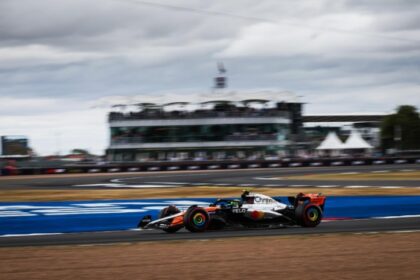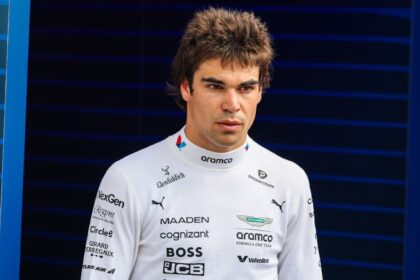BUDAPEST, Hungary – McLaren Racing CEO Zak Brown left his team’s motorhome on Sunday evening, crossing paths with a crowd of journalists eager for a conversation with team principal Andrea Stella. Shortly before, the battle for victory between the two McLaren drivers, Lando Norris and Oscar Piastri, was inches away from a collision on the penultimate lap of the Hungarian Grand Prix, raising the excitement both in the pit wall and in the stands.
“In case anyone didn’t notice,” Brown told reporters, “… it was a good race!”
Zak BrownFollowing the usual dynamic between Brown and Stella, Brown provided the headline, while Stella offered a more detailed analysis of Norris’ victory over Piastri. The central message was clear: McLaren has always allowed its drivers to compete, and in Budapest they proved it. In a competition as close as Sunday’s, hindsight always offers the loser a path to victory. On this occasion, Norris’s fifth victory of the season depended on an unfavored one-stop strategy, which turned out to be the fastest. On the other hand, Piastri, despite a two-stop strategy that was considered the most favorable, was apparently at a disadvantage.“You know, when you lose a race by so little, it’s a bit painful, but I’m sure it was entertaining from the outside,” Piastri commented. “It was entertaining from the inside too, a pretty fun race, considering everything, but obviously, when you’re on the losing side of that battle, it’s a bit difficult.”
Oscar PiastriFor Norris, emotions went in the opposite direction. After a bad start, his chances of victory seemed nil, and it was as his alternative strategy unfolded that belief began to grow.“I didn’t really think it would work for most of that second stint,” Norris said. “But with every lap, I gained more confidence that I would get closer and closer. So, yeah, it’s definitely rewarding.”
Lando NorrisWas the division of strategies fair?
The battle between the McLaren drivers had an added complication from the start due to the presence of Charles Leclerc, who started from pole position. The Ferrari driver led the race at the first corner and, initially, had the pace to keep Piastri at bay, while Norris fell to fifth place on the first lap, before recovering fourth place on lap 3. McLaren had considered the possibility of a one-stop strategy before the race, but favored a two-stop as the best option. By initiating pit stops on lap 18 and committing to a two-stop strategy with Piastri, there was the possibility that the Australian’s new tires would offer a performance advantage to overtake Leclerc and take the lead.“Our base strategy today was a two-stop strategy,” Stella explained on Sunday night. “We didn’t necessarily believe that a one-stop strategy was possible, so with Oscar we tried to follow a good two-stop strategy, trying to overtake Leclerc on the first stop. Then we tried to extend [the duration of the second stint] with the second stop to have a difference in [tire performance] and be able to have those tenths of a second to be able to overtake Leclerc, and this worked.”
Andrea StellaStella went on to explain that, by extending Norris’s one-stop strategy, they didn’t believe it was possible, but highlighted Norris’s ability to maintain a strong pace on used tires. “It wasn’t like going into the race with one or two stops and we would have chosen between them as equivalents; we thought the two-stop strategy would be dominant today.” Piastri mentioned that he was offered a one-stop strategy in the first stint, but, given his battle with Leclerc, who seemed strong before his race pace deteriorated due to a problem with the car, he doubted it would help his situation.The main benefit of the one-stop strategy, which perhaps wasn’t fully considered before the race, was the clean air it provided to Norris. While Piastri was stuck behind Leclerc for the first two stints, Norris was able to run alone for most of his race and exploit the true performance advantage that McLaren had at the Hungaroring.“We spoke a bit before the race, so it wasn’t completely ruled out,” Piastri said about the one-stop strategy. “In the race I was asked about it, but it’s very difficult to know from the cockpit what the best thing to do is. When you’re the trailing car [like Norris], your risk-reward ratio is always very different. So, yeah, there’s always that. Could we have matched Lando? That is, I suppose, the question I don’t have the answer to. So, I guess that’s the only thing. But we wanted to try and win the race as well, and the best way to try and beat Lando is by trying to win the race as well. That was obviously the intention, but I think we’ll definitely analyze if there’s anything we could have done a little differently.”
Oscar PiastriWhen the one-stop strategy was first offered to Norris, it involved staying on track longer than he had initially planned with his first set of tires. At that moment, he didn’t see the strategy itself as a path to victory, but rather as a way to unlock other potential benefits if a safety car or virtual safety car allowed him to make a more time-efficient pit stop.“Lando was on a different strategy and had more clean air, more laps where he could use the full potential of the car,” said Stella. “Oscar spent quite a bit of time behind Leclerc, and this might have cost him a bit of time, but I think both executed their race at the highest level.”
Andrea Stella“When Will [Joseph, Norris’s engineer] asked me: ‘What do you think of the one-stop?’ I think at that point, I was already like seven seconds behind Oscar and eight or nine behind Charles. It’s not that I thought my race was over, but it was pretty slim that I could at least fight from there, even with a perfect two-stop strategy. So, my expectations weren’t high, but I was more betting on a safety car or a [virtual safety car] or something to bring me back into the race, but I didn’t get any of that. In the end, I guess it didn’t matter. Will said: ‘What do we think of a one-stop?’ and I said: ‘Let’s do it’. My confidence wasn’t the highest, but it was my best chance to try and do something, and it turned out to be a bit more complicated because it actually allowed me to fight until the end for the victory. I’m still not sure if it was the best strategy, but I think with how difficult it was to overtake, it turned out to be pretty good.”
Lando NorrisWill McLaren maintain harmony?
Divergent strategies led the two drivers to a direct wheel-to-wheel battle in the final three laps of the race. Piastri’s second pit stop meant he had fallen behind Norris on track on lap 45, but his tires, 14 laps fresher, allowed him to reduce a gap of more than 10 seconds in the space of 20 laps. With the use of DRS and a slipstream on the pit straight, Piastri saw an opportunity on lap 69 of 70 and tried to seize the moment.Piastri locked a front tire, but didn’t touch the rear of Norris’s car. Three races earlier, in Austria, Piastri received a warning from the pit wall for a similar incident, but Stella was proud of the way his two drivers handled what could have been a crucial moment in Hungary.“I think I needed to be at least a couple of tenths closer, which was going to require a mistake from Lando to achieve,” Piastri said. “I feel like that was going to be my best chance. You never want to try and save it for the next lap and then it never comes. So, I thought I’d at least have a go, and yeah, not quite.”
Oscar Piastri“You know, when you have two great drivers, like Lando and Oscar, who are competing for a win in a Formula 1 grand prix and competing for the drivers’ championship, it’s always going to be very close,” Stella said. “But that was a firm race, it was a fair race at the same time. It was definitely within our principles. We had a little lock-up with Oscar, but at the same time, Lando left some space because he knew Oscar would be on the limit of the braking.”
Andrea Stella“We continue to be very proud of how Lando and Oscar compete. I think this is a great way to honor Formula 1 racing. These are the values of McLaren.” The question is whether those values can be maintained until the end of the season. With 10 races remaining, the most potent blows, perhaps, are still being dealt as the two drivers compete wheel to wheel. If a race like the one in Budapest were the deciding factor for the title later in the year, lap 69 might not be so clean and divergent strategies could generate much more controversy. But Stella, like Brown, is clear: McLaren is committed to letting its drivers compete.“Well, we are McLaren Racing: we bring the value of racing to Formula 1,” Stella said. “We want to offer great racing to Formula 1, we want to give our two drivers the possibility to use and express their talent, pursue their aspirations, their personal and business success within the limits of the team’s interest and fairness, sportsmanship and mutual respect. And for me, this is what I see. When we have a different strategy, when we have different options, I think this is part of racing. We want to make sure that neither of the drivers is surprised, and I think neither of the drivers was surprised. So far, I can only be very grateful for the way Lando and Oscar have interpreted the way we race as a team, as a group that includes the drivers, and I am sure that this will continue until the end of the season.”
Andrea Stella









